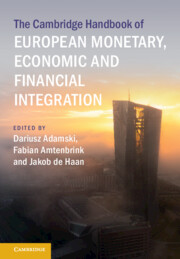Book contents
- The Cambridge Handbook of European Monetary, Economic and Financial Integration
- The Cambridge Handbook of European Monetary, Economic and Financial Integration
- Copyright page
- Contents
- Contributors
- Introduction
- Part I The Economic and Monetary Union
- 1 Conceptual Foundations of Economic and Monetary Union
- 2 Theorizing Economic and Monetary Union
- 3 Monetary Union and the Single Currency
- 4 On the Misalignment of Monetary, Economic, and Political Integration in European Economic and Monetary Union
- 5 Ideas, Interests, and Power
- 6 Coping with Economic Crises through Learning by Doing
- 7 The Political Economy of Reinsurance
- 8 Euro Crises, the Productivity Slowdown, and the EMU
- Part II The Monetary Dimension
- Part III The Economic and Fiscal Dimensions
- Part IV Financial Integration
- Index
- References
1 - Conceptual Foundations of Economic and Monetary Union
The Economic Dimension
from Part I - The Economic and Monetary Union
Published online by Cambridge University Press: 28 September 2023
- The Cambridge Handbook of European Monetary, Economic and Financial Integration
- The Cambridge Handbook of European Monetary, Economic and Financial Integration
- Copyright page
- Contents
- Contributors
- Introduction
- Part I The Economic and Monetary Union
- 1 Conceptual Foundations of Economic and Monetary Union
- 2 Theorizing Economic and Monetary Union
- 3 Monetary Union and the Single Currency
- 4 On the Misalignment of Monetary, Economic, and Political Integration in European Economic and Monetary Union
- 5 Ideas, Interests, and Power
- 6 Coping with Economic Crises through Learning by Doing
- 7 The Political Economy of Reinsurance
- 8 Euro Crises, the Productivity Slowdown, and the EMU
- Part II The Monetary Dimension
- Part III The Economic and Fiscal Dimensions
- Part IV Financial Integration
- Index
- References
Summary
Europe’s economic and monetary union is a work in progress. This chapter sketches the direction that further progress should take. Key steps include building on the precedent of the Recovery Plan for Europe by further enlarging the EU’s borrowing capacity, developing revenue sources adequate for servicing and repaying EU debt, reforming and simplifying the EU’s fiscal rules, and creating a fully funded union-wide deposit insurance scheme. In addition, progress will require supplementing the numerical rules and reference values of the Stability and Growth Pact with independent policy-making institutions at the national level. This will provide a superior basis for the operation of the euro area’s policy process.
- Type
- Chapter
- Information
- Publisher: Cambridge University PressPrint publication year: 2023



